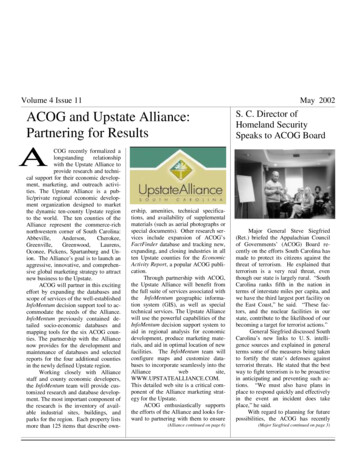
Transcription
Volume 4 Issue 11May 2002ACOG and Upstate Alliance:Partnering for ResultsCOG recently formalized alongstandingrelationshipwith the Upstate Alliance toprovide research and technical support for their economic development, marketing, and outreach activities. The Upstate Alliance is a public/private regional economic development organization designed to marketthe dynamic ten-county Upstate regionto the world. The ten counties of theAlliance represent the commerce-richnorthwestern corner of South eenwood,Laurens,Oconee, Pickens, Spartanburg and Union. The Alliance’s goal is to launch anaggressive, innovative, and comprehensive global marketing strategy to attractnew business to the Upstate.ACOG will partner in this excitingeffort by expanding the databases andscope of services of the well-establishedInfoMentum decision support tool to accommodate the needs of the Alliance.InfoMentum previously contained detailed socio-economic databases andmapping tools for the six ACOG counties. The partnership with the Alliancenow provides for the development andmaintenance of databases and selectedreports for the four additional countiesin the newly defined Upstate region.Working closely with Alliancestaff and county economic developers,the InfoMentum team will provide customized research and database development. The most important component ofthe research is the inventory of available industrial sites, buildings, andparks for the region. Each property listsmore than 125 items that describe own-S. C. Director ofHomeland SecuritySpeaks to ACOG Boardership, amenities, technical specifications, and availability of supplementalmaterials (such as aerial photographs orspecial documents). Other research services include expansion of ACOG’sFactFinder database and tracking new,expanding, and closing industries in allten Upstate counties for the EconomicActivity Report, a popular ACOG publication.Through partnership with ACOG,the Upstate Alliance will benefit fromthe full suite of services associated withthe InfoMentum geographic information system (GIS), as well as specialtechnical services. The Upstate Alliancewill use the powerful capabilities of theInfoMentum decision support system toaid in regional analysis for economicdevelopment, produce marketing materials, and aid in optimal location of newfacilities. The InfoMentum team willconfigure maps and customize databases to incorporate seamlessly into theAlliancewebsite,WWW.UPSTATEALLIANCE.COM.This detailed web site is a critical component of the Alliance marketing strategy for the Upstate.ACOG enthusiastically supportsthe efforts of the Alliance and looks forward to partnering with them to ensureMajor General Steve Siegfried(Ret.) briefed the Appalachian Councilof Governments’ (ACOG) Board recently on the efforts South Carolina hasmade to protect its citizens against thethreat of terrorism. He explained thatterrorism is a very real threat, eventhough our state is largely rural. “SouthCarolina ranks fifth in the nation interms of interstate miles per capita, andwe have the third largest port facility onthe East Coast,” he said. “These factors, and the nuclear facilities in ourstate, contribute to the likelihood of ourbecoming a target for terrorist actions.”General Siegfried discussed SouthCarolina’s new links to U. S. intelligence sources and explained in generalterms some of the measures being takento fortify the state’s defenses againstterrorist threats. He stated that the bestway to fight terrorism is to be proactivein anticipating and preventing such actions. “We must also have plans inplace to respond quickly and effectivelyin the event an incident does takeplace,” he said.With regard to planning for futurepossibilities, the ACOG has recently(Alliance continued on page 6)(Major Siegfried continued on page 3)
Page 2VIEWPOINTThe Office for Domestic PreparednessAnti-Terrorism and EmergencyTraining for Local GovernmentsThe Office for Domestic Preparedness (ODP) is the program office withinthe Department of Justice (DOJ) responsible for enhancing the capacity ofstate and local jurisdictions to respondto, and mitigate the consequences of, incidents of domestic terrorism.In the 1998 Appropriations Act(Public Law 105-119) and accompanying report, the Congress expressed itsconcern regarding the real and potentially catastrophic effects of a chemicalor biological act of terrorism. Congressstated that, while the Federal Government plays an important role in preventing and responding to these types ofthreats, state and local public safetypersonnel are typically first to respond to the scene when such incidentsoccur. As a result, Congress authorizedthe Attorney General to assist state andlocal public safety personnel in acquiring the specialized training and equipment necessary to safely respond to andmanage terrorist incidents involvingweapons of mass destruction (WMD).To execute this mission, the Office ofJustice Programs established ODP todevelop and administer a national Domestic Preparedness Program.TrainingODP utilizes the capabilities of anumber of specialized institutions in thedesign and delivery of its training programs. These include private contractors, other Federal and state agencies,the National Domestic PreparednessConsortium, the National TerrorismPreparedness Institute at St. PetersburgJunior College, the U.S. Army's PineBluff Arsenal, and the National Sheriff'sAssociation.Center for Domestic Preparedness (CDP):The CDP provides handson specialized training tostate and local emergencyresponders in the management and remediation ofWMD incidents. Located at the formerhome of the U.S. Army ChemicalSchool, Fort McClellan, Alabama, theCDP conducts live chemical agent training for the nation's civilian emergencyresponse community. The trainingemergency responders receive at theCDP provides a valid method for ensuring high levels of confidence in equipment, procedures, and individual capabilities. The CDP offers two trainingWMDcoursesofinstruction:HAZMAT Technician and WMD Incident Command. For additional information on this program, contact theCDP at (256) 847-2132 or )(AcademyofCounterTerrorist Education): LSU providestraining to law enforcement agenciesand focuses its efforts on the delivery ofthe Emergency Response to Terrorism:Basic Concepts for Law EnforcementCourse, and the development and delivery of the Emergency Response to Domestic Biological Incidents Course.LSU offers two courses of instruction,Emergency Response to Biological Incidents and the Law Enforcement Response to WMD Incidents course. Foradditional information on LSU courses,contact LSU at www.ace.lsu.eduTexasA&MUniversity(National Emergency Response andRescue Training Center): Texas A&Mdelivers a set of courses to prepare public officials, emergency medical services, law enforcement, fire protection,and public works for the threat posed byweapons of mass destruction. Coursesare developed and designed to provideeach specific segment of the emergencyresponse community with the toolsneeded to accomplish its role in theevent of a WMD incident. Additionally,Texas A&M has developed an Interactive Internet WMD Awareness Coursefor emergency responders. Texas A&Malso provides technical assistance tostate and local jurisdictions in the development of WMD assessment plans.TEEX offers the following courses ofinstruction: WMD Threat and Risk Assessment, WMD Incident Management/Unified Command, EmergencyResponse to Terrorism Basic Concepts,Emergency Medical Operations, andWMD Awareness (Internet Course).For additional information on pusnerrtc@teexmail.tamu.eduTerrorismAwareness andEMS ConceptsOnline Training for Officialsand First RespondersTexas A&M University (the National Emergency Response and RescueTraining Center) is offering interactiveInternet training, at no cost, to stateand local officials and first responders.The course provides an excellent overview of terrorism awareness and firstresponder basics. The program includesself tests, a final exam and a certificate(Training continued on page 3)
VIEWPOINTPage 3Easley Adopts Land Development Regulationsn April 8, 2002, the City ofEasley adopted a Land Development Regulations Ordinance at a second readingby the City Council. The adoption ofthis ordinance is a culmination of over ayear’s effort by the Planning Commis-quirements. Subdivision plans are reviewed by the Planning Commissionand administered by city staff.The Land Development Regulations Ordinance will guide large-scaledevelopments like this project locatedon U.S. Highway 123 in Easley.(Training continued from page 2)for successful completion. The Terrorism Awareness Course fulfills the prerequisite requirement for the Department of Justice Incident Commandtraining at Ft. McClellan, Alabama.sion, staff and City Council of Easley.The Appalachian Council of Governments assisted the City of Easley withthe development of the Land Development Regulations Ordinance. The newordinance, which updates the existingSubdivision Ordinance, was in responseto changing conditions within the cityand to address concerns voiced by citizens over the past few years. The Planning Commission and City Councilhave done well in addressing these issues and have adopted an ordinance thatis sensitive to the needs of the City ofEasley.The purpose of the Land Development Regulations Ordinance is to establish standards, procedures, and minimum requirements in accordance withthe comprehensive plan; to regulate andcontrol the location, design, subdivisionand assemblage of land and buildings;to define the procedures for administration of subdivision review; and to guidethe general development of real estatein the city. Unlike a land use plan, theland development ordinance is a regulatory document addressing the generaland supplementary regulations, administrative mechanisms, code compliance,street and sidewalk layout and composition, and other items, including the location of infrastructure and parking re-Terrorism Awareness for EmergencyFirst RespondersFrom the smallest pipe bomb tothe horror of the Oklahoma City bombing, terrorism presents added concernsto those involved in emergency response. This course addresses theunique requirements of those incidentsand provides an overview of terrorism,weapons of mass destruction, and incident command and control.EMS Concepts for WMD IncidentsOn most calls, EMS first responders are initially concerned with victimsin need of medical attention. However,the unique nature of a terrorist incidentinvolving Weapons of Mass Destruction (WMD) calls for a different protocol. While the focus of this course isprimarily on the treatment of patients atmass causality sites, responders mustalso be aware of unique considerationsassociated with terrorist events.For additional information concerning interactive WMD training,contact Joe Newton at ACOG, or goo n l i n et Corporation Loanshe ADC Board approved aloan to Innovative Container Systems (ICS) in theamount of 100,000 toassist Carolina First in funding equipment for a new cleaning line projectthat will cost 250,000. ICS recyclesand cleans plastic 55-gallon drums foruse throughout the Southeast. ICSemploys almost 30 people and will beexpanding with the additional equipment.The ADC Board also approved aloan of 20,000 for Celestial NailBoutique, a new business to be located in the Golden Strip area inGreenville County. The owner, KathyArmstrong, has put together a projectto open the new service business providing professional nail care. Thebusiness plans on employing up toeight people.The ADC has had an SBA 504loan approved by the Small BusinessAdministration to provide permanentfunding for Palmetto Graphics. Palmetto Graphics is a locally ownedprinting company that is moving fromleased quarters to a building they arepurchasing near Pelham Road inGreenville County. Palmetto Graphics is owned by the Neal family andhas been in business for over 15 years.The business is also purchasing a fivecolor printing press to expand theircapabilities.The Appalachian DevelopmentCorporation has now closed andfunded over 1 million in revolvingloans since the start of its fiscal year,October 1, 2001.(Major Siegfried continued from page 1)conducted terrorism awareness trainingfor local elected officials in the region,provided a briefing for local administrators on security precautions at theOconee Nuclear Facility, and hosted aseminar on water system security measures.
Page 4VIEWPOINTFive-Year Reauthorization Approved for ARCLong-Term CareOmbudsman Programn March 12, President Bushsigned a five-year reauthorization bill for the AppalachianRegionalCommission(ARC). The bill authorizes 446 millionoverthefiveyear periodfor area development(non-highway) programs; 88 millionannually for FY 2002 through 2004, 90 million for FY 2005, and 92 forFY 2006.The measure passed on a voicevote in the House and Senate in lateFebruary. This is in contrast to the lastreauthorization three years ago, whichwas marked by much debate and manyproposed amendments. Some of thekey provisions of the reauthorizationbill are: Maintains support for the region’smulti-county planning and development agencies (Councils of Governments or Local DevelopmentDistricts) Establishes an Interagency Coordinating Council on Appalachia Authorizes a new telecommunications program Authorizes an entrepreneurial initiative Authorizes a new Regional SkillsPartnership program.he Long Term Care Ombudsman Program is designed to improve thequality of care and service to residents (vulnerable adults overage 18) residing in long term care facilities. The Program was begun in 1972through initiatives of the Nixon Administration as a result of a public outcry against conditions in nursing homesin the late 1960's and early 1970's. Jurisdiction of the Program currently extends to nursing homes, residential carehomes (retirement centers, assisted living facilities, etc.), psychiatric hospitals,community training homes for the mentally retarded and other facilities operated by or licensed for operation by theDepartments of Mental Health and Disabilities and Special Needs. The enabling legislation for the Program includes the Older Americans Act, StateOmbudsman's Act, and The OmnibusAdult Protection Act. Facilities arerequired to provide full access, including records, to the Ombudsman Program as needed to carry out its duties.The Ombudsman wears two hats “complaintinvestigator”and“advocate.”As COMPLAINT INVESTIGATOR, the Ombudsman receives andinvestigates any complaint filed by, oron behalf of, a resident. The complaintmay include anything that adverselyaffects the quality of care and life, i.e.,quality of food, untimely service, staffunresponsiveness, transfer/discharges,staffing, abuse, neglect, and exploitation.First and foremost, the residentcontrols the complaint process. He/shedetermines the extent to which the ombudsman becomes involved in solvingtheir problem.When a resident cannot speak onhis/her behalf, the ombudsman mayassist the legal representative, familymember, or sponsor on behalf of theresident.The ombudsman works with theresident to identify the problem or toARC States’ Co-Chairman DonSundquist, Governor of Tennessee,stated “I want to commend Congress aswell as President Bush for the strongsupport they’ve given the AppalachianRegional Commission. Thanks to ARCand the support of Congress, thousandsof Americans throughout Appalachiatoday have opportunities for a better lifethat were hardly imaginable a generation ago.”South Carolina receives approximately 2.3 million in ARC funding annually for area development activities inthe six-county Appalachian region.Greenville County, however, is cur-rently classified as an AttainmentCounty and is not eligible for ARC assistance.For more information about theARC program, contact Dirk Reis at theACOG.Older AmericansMonth — May 2002“America: ACommunity for AllAges” — http://www/AOA.GOV/may2002/default.htmAccording to Josefina G. Carbonell, Assistant Secretary for Aging,this year’s theme, “America: A Community for All Ages,” was selected inrecognition of the national communityin which we live, and in tribute to theelders of our families who represent thestrength of our nation. Older Americans provide us with love and guidance, and they set the standards bywhich our families and our children’sfamilies live their lives as responsiblecitizens of our great nation. In essence,older Americans are the heartbeat ofour communities, and they give us theenergy and motivation to move forwardand contribute to our nation’s strength,success and prosperity.Celebrate these May and OlderAmericans Month activities: National Senior Travel Month National Physical Fitness andSports Month National Arthritis AwarenessMonth National Allergy AwarenessMonth National Senior Center Week National Intergenerational Week National Osteoporosis PreventionMonth(LTC continued on page 5)
VIEWPOINTPage 52001 Year-End Reviewouth Carolina’s economysputtered throughout theyear due to the effects of anational recession and significant job losses in manufacturing.The non-agricultural count tumbled 1.3 percent to 1.8 million in 2001,losing 24,200 jobs. Manufacturing lost15,100 over the year. Not all of thelosses were due solely to the nationalrecession. The state has been losingtextile and apparel jobs for three decades, independent of overall economicrecessions and expansions.Withinmanufacturing, employment in textilemills fell by 6,000. Trade lost 8,700jobs, led by a decline of 6,700 jobs inretail trade. Construction shed 1,600over the year.Industries postinghealthy employment gains over the yearwere finance, insurance and real estate( 2,100); service ( 1,500); and transportation and public utilities ( 500).A production worker in SouthCarolina’s manufacturing industriesearned on average 11.19 an hour in2001, up .22 from 2000. Averageweekly earnings in manufacturing increased 1.51 over the year to 467.74.Workers in paper and allied productswere the highest hourly wage earners, at 14.65 per hour, followed by chemicalsand allied products ( 13.65 per hour)and stone, clay and glass products( 11.80 per hour).In 2001, a total of 5.28 billionwas invested in South Carolina, addingan announced 21,937 new jobs. Existing industries accounted for over 70percent of the job creation total. Overthe past 10 years, nearly 51 billion hasbeen invested in the state, creating morethan 252,000 new jobs. The leadingmanufacturing sectors in terms of capital investment activity were metals andcapital equipment ( 966 million),chemicals ( 593 million), and rubberand plastics ( 343 million).Greenville County led the state ininvestment, recording 1.3 billion, followed by York ( 652.7 million), Jasper( 451.7 million) Cherokee ( 351.4 million) and Lexington ( 310.4 million)counties. York County ranked first inthe number of announced jobs created,with 3,844, with Greenville (2,936),Richland (1,591), Spartanburg (1,368)and Lexington (1,234) counties next onthe list.The state’s seasonally adjusted unemployment rate for 2001 was 5.4 percent, up from 3.9 percent in 2000. Ninecounties averaged double-digit unemployment rates, led by Marion Countyat 17.3 percent. Conversely, 15 counties averaged unemployment rates below 5.4 percent. Beaufort County hadthe state’s lowest unemployment rate, at2.6 percent. The unemployment rate forColumbia MSA averaged 3.2 percentfor the year. The Charleston andGreenville-Spartanburg MSA’s unemployment rates averaged 3.7 percent and4.6 percent, respectively. Nationally,the seasonally adjusted unemploymentrate was 4.8 percent in 2001.For 2002, economists predict thecurrent recession to end by the spring,since recession tens to average 11months. The state’s unemployment ratewill peak slightly over 6.0 percent. Bycomparison, during the recession of theearly 1980’s, he state’s unemploymentrate climbed to nearly 12 percent. Inthe early 1990’s, unemployment rose ashigh as 8 percent.The 30-year trend of declining textile employment is expected to continue. Based on 1998-2002 employment projections, the fastest-growingsectors will continue to be services,construction, and wholesale and retailtrade. Services will provide 1 out ofevery 2 new jobs in the state; trade willaccount for 29 percent of an overall jobgrowth, while nearly 15,000 construction jobs are anticipated to be added by2008. Non-residential construction activity should continue to surge as SouthCarolina firms continue to invest incapital expansion.Reprint of an article by Mike Daniels, Supervisor, LMI Research Unit, Labor Market Information, South Carolina Employment SecurityCommission, appearing in the January 2002 issueof the South Carolina Workforce Trends.(LTC continued from page 4)break a big problem down into smaller,more manageable pieces. The ombudsman also tries to determine whether thisis a problem throughout the facility.The ombudsman first investigatesthe complaint to determine whether it isvalid. If valid, the ombudsman workswith the complainant to resolve thecomplaint. If not valid, the ombudsmanwill explain his findings.The ombudsman will then followup to ensure that any agreement reachedto solve the problem is actually carriedout.In all cases, complaints are handled confidentially. The ombudsmandoes not disclose the complainant’sidentity without his/her permission,unless ordered to do so by a court oflaw. Even if the ombudsman cannotresolve the complaint without revealingthe complainant’s identity, he/shemakes the choice as to whether the ombudsman proceeds.As ADVOCATE, the Ombudsman protects Residents’ Rights andworks to ensure the highest quality ofcare for vulnerable adults who mostoften feel powerless and are too illand/or too frail to stand up for their ownrights.The Ombudsman identifies andseeks to remedy gaps in facility, government, or community services, advocates for improvements in state andfederal laws and regulations to improvequality of care, educates residents, family, and staff about residents’ rights,provides technical assistance in establishing Resident and Family Councils,and provides information and referralregarding long-term care programs andservices to any interested party.WHO TO CONTACT — Callthe Appalachian Council of Governments’ Long Term Care Ombudsmantoll free:Anderson CountyCherokee CountyGreenville CountyOconee CountyPickens CountySpartanburg 1403
Page 6VIEWPOINTSE4A Scholarshipnce again, the Southeastern Association of Area Agencies on Aging has established a scholarship to be awarded to astudent interested in pursuing a career in Gerontology or Geriatrics. Two 1,000 scholarships will be awarded in thefall of 2002.To apply for the scholarship, a student must be a junior, senior or graduate student presently enrolled in an accredited university within the eight Southeastern states of Alabama, Georgia, Mississippi, Florida, Tennessee, Kentucky, NorthCarolina and South Carolina.If you, or someone you know, would be interested, please contact Michael Stogner at the ACOG office for a copy of the application and a list of the criteria. Completed applications must be returned before May 31, 2002.(Alliance continued from page 1)successful economic development in Upstate South Carolina. Please visit WWW.UPSTATEALLIANCE.COM to learn moreabout the Upstate Alliance.For more information about InfoMentum, please contact Carol Andersen at ACOG(andersen@scacog.org).VIEWPOINTAppalachian Council of GovernmentsP. O. Drawer 6668Greenville, South Carolina 29606PRSRT STDU.S. POSTAGEPAIDGREENVILLE, SCPERMIT NO. 1604
LSU offers two courses of instruction, Emergency Response to Biological In-cidents and the Law Enforcement Re-sponse to WMD Incidents course. For additional information on LSU courses, contact LSU at www.ace.lsu.edu Texas A&M University (National Emergency Response and Rescue Training Center): Texas A&M delivers a set of courses to prepare pub-











